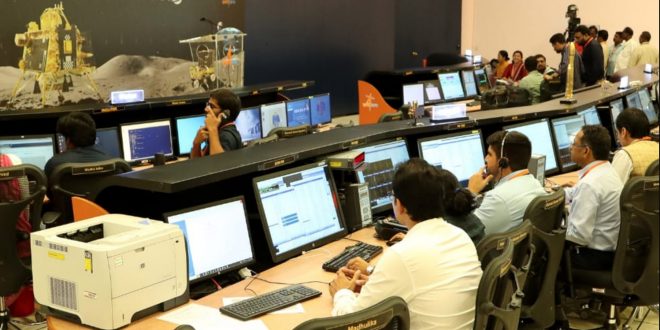After failing in 2019, Chandrayaan-3, India’s latest moon mission, landed on the moon.
India became the fourth nation to softly land on the moon, after the former Soviet Union, the U.S., and China, and the first to land on the lunar south pole, an unexplored area that is expected to help scientists understand the moon’s atmosphere and pave the way for future space exploration.
“Chandrayaan-3 is a result of the work done by thousands of scientists, engineers, our staff and industries and support teams across ISRO and other places, other institutions,” ISRO chairman S. Somanath told the audience after the landing.
Russia’s Luna-25 was scheduled to land softly on the south pole before India’s Chandrayaan-3 earlier this month. After losing contact with Roscosmos, the Russian spacecraft crashed into the moon on Saturday.
On July 14, ISRO launched Chandrayaan-3 using its “Launch Vehicle Mark-III” vehicle. The Satish Dhawan Space Centre in Sriharikota, South India, launched it.
Chandrayaan-3, India’s third Chandrayaan mission (“moon vehicle”), aims to land and rove on the moon safely and conduct scientific experiments. For less than $75 million, the spacecraft’s propulsion module, lander, and rover carry seven scientific instruments.
The Chandrayaan-3 lander has better sensors, software, and propulsion to fix its predecessor’s issues. ISRO also conducted simulations and testing to make the lander more rugged for a successful landing.
The lander will measure seismic vibrations, near-surface plasma, lunar temperature, thermal conductivity, elemental composition, and Earth spectral signatures.
The U.S. will launch Artemis III, a crew mission to the lunar south pole, in 2025. The Chandrayaan-3 mission in India will help understand the surface before the human landing.
The rover of Chandrayaan-3 is identical to that of Chandrayaan-2, unlike the lander. The lander and rover will last one lunar day, or 14 days on Earth.
Chandrayaan-3 follows 14 years after India’s 2008 moon landing mission found water molecules in the lunar atmosphere.
The Chandrayaan-2 lander-rover crashed during touchdown, but its orbiter is still studying the moon. The Chandrayaan-2 orbiter helped locate the Chandrayaan-3 lander’s landing site and will continue to send signals to Earth for communication.
“This is not our work alone. A generation of ISRO leaders and scientists created this. This journey began with Chandrayaan-1 and continues with Chandrayaan-2, which is still communicating with us. Somanath said we should remember and thank all the teams that built Chandrayaan-1 and Chandrayaan-2 while celebrating Chandrayaan-3.
India has become interested in space exploration in recent years. Over 100 space tech startups have helped South Asia develop launch vehicles, satellites, and hyperspectral earth imaging. New Delhi introduced a space policy to encourage private-government collaboration.
“India’s successful moon mission is not just India’s alone,” said Narendra Modi. Our approach of one Earth, one family, one future resonates globally. This human-centric approach we represent is universally accepted. Our moon mission is also human-centered. Thus, this success belongs to humanity and will aid future moon missions by other nations. I believe all nations, including the global south, can accomplish such feats. We can all aim for the moon and beyond.”
ISRO has been planning other missions besides Chandrayaan-3. Long-planned human space flight mission Gaganyaan and solar observatory project Aditya L1 probe the sun.
“We applaud ISRO on the successful landing of the Chandrayaan-3, which shows India’s strong spirit of space exploration and our prowess in the space domain,” said Indian Space Association director General Lt. Gen. AK Bhatt in a statement. This means these moon landings will boost our lunar economy and encourage Mars and beyond celestial exploration. More private players and our growing space-tech startups will help India lead the global space economy in space exploration and commercialization.
India signed NASA’s Artemis Accords in June to collaborate on space exploration. NASA will also train Indian astronauts at the Johnson Space Center in Houston and send them to the ISS next year. ISRO and NASA are also collaborating to launch a low-Earth observatory (LEO) in 2024 to map the planet in 12 days and provide consistent data on Earth’s ecosystems, ice mass, vegetation biomass, sea level, and natural disasters and hazards.
 Tech Gadget Central Latest Tech News and Reviews
Tech Gadget Central Latest Tech News and Reviews




